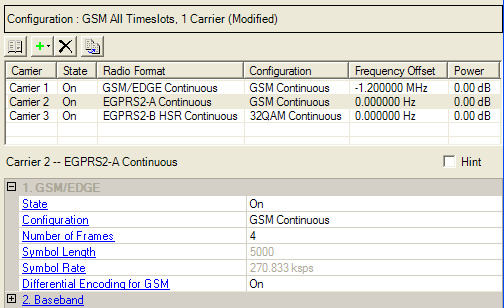

Choice: On | Off
Default: On
Double-click or use the drop-down menu to set the operating state of the carrier to or .
Choice: GSM Continuous | EDGE Continuous
Default: GSM Continuous
Select a continuous pattern type from the  drop-down menu.
drop-down menu.
Choice: GSM Continuous | EDGE Continuous | 16QAM Continuous | 32QAM Continuous
Default: GSM Continuous
Select a continuous pattern type from the  drop-down menu.
drop-down menu.
Choice: QPSK Continuous | 16QAM Continuous | 32QAM Continuous
Default: QPSK Continuous
Select a continuous pattern type from the  drop-down menu.
drop-down menu.
Range: 1 to 511
Default: 4
Enter the number of frames for the selected carrier.
The number of frames in a multi-carrier waveform is determined by the carrier with the largest number of frames. In carriers in the waveform with fewer frames, the frames are repeated until the number of frames matches that in the longest carrier. For example, for two carriers A and B in the same waveform, if A has 10 frames and B has 3 frames, B is repeated 3 times completely, then one more frame from B is used before both A and B start again.
The maximum waveform length depends on the oversampling ratio, the number of carriers, and your PC resources, (memory size). If an Out of Memory error is reported, reduce the number of frames, the number of carriers, or the maximum Frequency Offset (reducing the Frequency offset, reduces the oversampling ratio which reduces the amount of PC memory required).
The software sets the symbol length based on the number of frames and the modulation type. You cannot edit the value in this cell.
View the GSM/EDGE/EGPRS2 symbol rate. You cannot edit the value in this cell.
Choice: On or Off
Default: On
Double-click or use the drop-down menu to set differential data encoding On or Off.
This setting is only available for GSM.